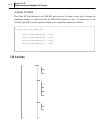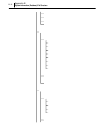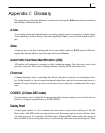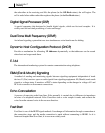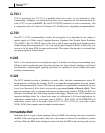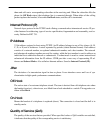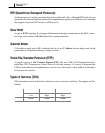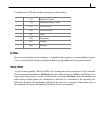
Appendix C
Glossary
G.723.1 G.723.1
G.723.1 (previously just "G.723") is a standards-based voice codec. It was designed for video
conferencing / telephony over standard phone lines, and is optimized for real-time encode & de-
code. G.723.1 is part of the H.323 (IP) and H.324 (POTS) standards for video conferencing. Has
a compression ratio of 5.3 and /or 6.3 kbits/sec (0.7-0.8 kbytes/sec), depending on implementation.
G.729 G.729
The ITU-U G.729 recommendation contains the description of an algorithm for the coding of
speech signals at 8 Kbit/s using Conjugate-Structure Algebraic-Code Excited Linear Prediction
(CS-ACELP). The CS-ACELP coder is fed with a digital signal resulting from telephone band-
width filtering (Recommendation G.712) of an analog signal sampled at 8 kHz, followed by con-
version to 16-bit linear PCM for input to the encoder. The output of the decoder is converted back
into analog signal by similar means.
H.H.245245
H.245 is line transmission of non-telephone signals. It includes receiving and transmitting capa-
bilities as well as mode preference from the receiving end, logical channel signaling, and Control
and Indication. Acknowledged signaling procedures are specified to ensure reliable audiovisual
and data communication.
H.323 H.323
The H.323 standard provides a foundation for audio, video, and data communications across IP-
based networks, including the Internet. H.323 is an umbrella recommendation from the Interna-
tional Telecommunications Union (ITU) that sets standards for multimedia communications over
Local Area Networks (LANs) that do not provide a guaranteed Quality of Service (QoS). These
networks dominate today’s corporate desktops and include packet-switched TCP/IP and IPX over
Ethernet, Fast Ethernet and Token Ring network technologies. Therefore, the H.323 standards are
important building blocks for a broad new range of collaborative, LAN-based applications for
multimedia communications. It includes parts of H.225.0 - RAS, Q.931, H.245 RTP/RTCP and
audio/video codecs, such as the audio codecs (G.711, G.723.1, G.728, etc.) and video codecs
(H.261, H.263) that compress and decompress media streams.
Immediate StartImmediate Start
Immediate Start is a type of trunk signaling. When the PBX at the sending end seizes a trunk line
the PBX at the receiving end sends a dial tone to the former to inform of its readiness to receive
call data. When the PBX at the sending end sends call data, the PBX at the receiving end receives



